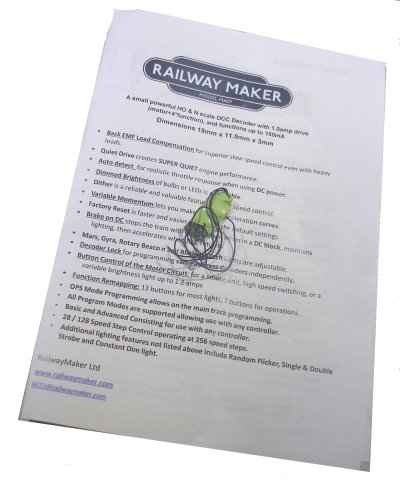
On eBay two UK vendors have been advertising Laisdcc decoders, which are made in Hong Kong, and being sold for as little as £6.99.
Although superficially the same decoder, there are differences between the two suppliers.
From e-mail correspondence with the vendors, Railway-Maker said, "we do use the laisdcc firmware"; the inference being that it is shipping the chips with programming of its own devising.
The Railway-Maker chip has a manufacturer's ID of '81', which, according to the NMRA ID guide, is notionally allocated to GoVerModels in Belgium. The vendor was unable to confirm that the chip was NMRA-approved. The instructions have a cut-and-paste feel about them, and a number of CV settings were listed, but it is NOT the full list. In subsequent correspondence I could not establish whether the full set of CVs as published by the manufacturer (laisdcc) were appropriate, or whether the settings as supplied were of Railway-Maker's own devising, although there is a close resemblance to TCS' own instructions.
It was not clear which CVs had been employed, as some were blank when read. Unfortunately the first Railway-Maker chip blew immediately it was placed back on the 'main' after re-programming, and so this testing process came to an abrupt end! It has been suggested that the live ends of the 'stay alive' wires might have come into contact with each other.
The other supplier is the Widget Shop. The Manufacturer ID (CV 8) is 153, which is also used by TCS. Various discussion groups suggest that the decoder bears a 'remarkable' physical resemblance to the TCS M4, and that some of the suggested CVs are similar to the TCS NEU651.
However, there are some observations which are common to both vendors':
1. DO check the small print, as there are 0.5 Amp decoders available, which are unsuitable for many mainstream Ready-to-run locos, such as the Heljans, Hornby 9F, etc. I did not spot this when buying the second decoder, but fortunately the Hornby Class 101 has suitable characteristics.
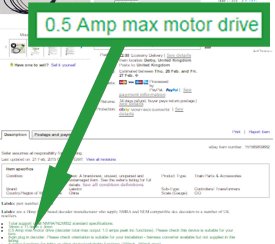
2. DO insulate the three 'stay alive' wires which are supplied with bare ends before you attempt to use the decoder. I didn't and blew the first decoder.
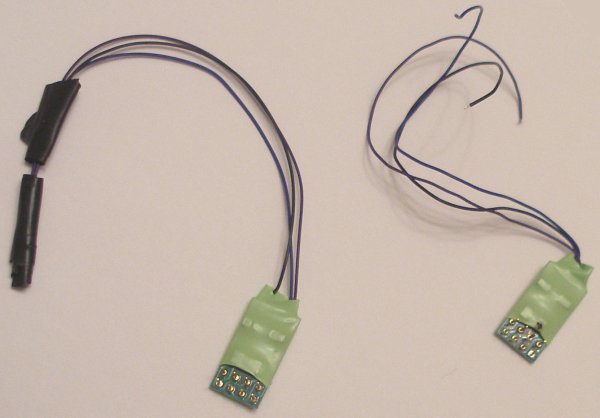
3. The low price reflects the fact that they have basic configurations, and so may benefit from being adjusted by the user. The Widget Shop supply a full list of recommended CVs. So if you are not confident writing CVs or have a starter DCC set-up such as the Lenz Compact then you won't be able to set-up the decoder. Having said that, I have used the 0.5 Amp version without adjustment in the Hornby Class 101 DMU.
4. To set these decoders, you need something that can read all the CVs, such as a SPROG. If using the SPROG Decoder Pro, select NMRA and Raw CVs 1 - 255. Select 'new locomotive' and you should be able to read all the CVs. If you select NMRA Standard CV definitions, you can see the value of the common CVs in tabular form. The CV tab in either of these will display all the CVs and allow you to set them.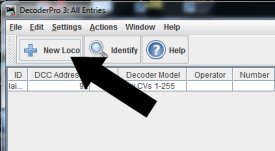
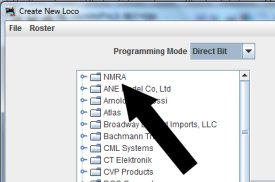
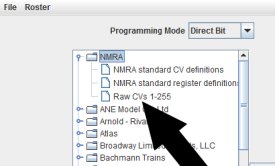
5. DO check the vendors returns policy. Railway-Maker won't accept returns under any circumstances once the decoder has been plugged into a loco, and/or recoded, so although there appears to be a returns policy, this is ONLY for goods rejected following visual inspection by the purchaser. The Widget Shop will accept items back in re-saleable condition, so you can get your money back if they can successfully reset the chip, although obviously if you have applied tape to the stay-alive wires, this action will have negated this particular 'condition'. There is a very good article on the Which? site here.
Having played with the CVs, the unit was finally tested on the layout....
Discussion:
Both the 0.5 Amp and 1 Amp versions appear to be too small for the locos I was intending to use them in. The 0.5 Amp version works very well in the Hornby Class 101 DMU, but both samples of the 1 Amp decoder, as suppled by Railway-Maker, have blown.
I have a Heljan Class 33 which I use for initial assessment of new chips, as it is a lovely runner. I now also know is a heavy current user. The decoder blew immediately power was applied, but I did not check where the ends of the 'stay alive' wires were and there is the possibility that they may have touched.
Having realised the importance of not using a high-current loco, I bought a second chip. This time the 'stay alive' wires were taped and the chip applied to Hornby Black 5. The loco ran well in DC mode, and I had established it required a lesser current than the Heljan 33.
With the decoder fitted, the loco ran beautifully forwards, but running backwards it ran erratically for about 30 seconds before it stalled and the chip blew.
Returning to eBay I have discovered a third reseller of similar chips, and quote his technical information below:
"Continuous Max Motor Power: 750mA. Recommended maximum motor power is 400mA to allow for all functions being active at 100mA each at same time as motor is running, keeping the total power output to under 1A max. Short Duration Peak Motor Power: 1A Function Output Power Rating: 100mA per output."
The conclusion therefore must be that if there is the slightest possibility that your loco is going to draw anything close to 1 Amp, these chips are not suitable.
I also had a discussion with one supplier as to how 'savvy' the modeller needs to be regarding the current being drawn. It was suggested that the modeller should be aware of the maximum current likely to be drawn, and if not, then they should carry out a stall test.
I shared this with Jonathan Edwards at Hornby who offered the following response:
"Most locomotives have the current draw information in the instruction leaflet, however, each peak would vary from locomotive to locomotive, layout to layout, and load to load. We do not have this information tabulated, so it would mean going through each instruction leaflet for each locomotive. Frankly, we are rather surprised that you have been asked for this information by a decoder supplier. We believe it is unreasonable to expect someone to be able to perform a stall test without the correct equipment or knowledge." I've highlighted Jonathan's last paragraph as I agree!
Finally, the laisdcc ship looks visually like a TCS standard decoder, and the instructions are very similar, if not identical. Interestingly I have a Gaugemaster decoder which also looks very similar to the laisdcc entity, and also works best in the 'low current' fleet.
In summary, these low-priced DCC decoders have not been the solution I was looking for. BUT, as Hornby rightly point out, there are a fist full of variables 'locomotive-to-locomotive, layout-to-layout, and load-to-load' which may have influenced my experiences. By way of comparison, I have just bought a used Zimo off eBay for the princely sum of £16. This has worked perfectly when tested in the Heljan Class 33, and is now installed without problem in its new permanent home. The moral here is that you probably do get what you pay for.
Tim Lowe of the Widget Shop has provided a detailed response to the above,and has provided detailed responses to a number of the points raised. Click here to read Tim's comments.
